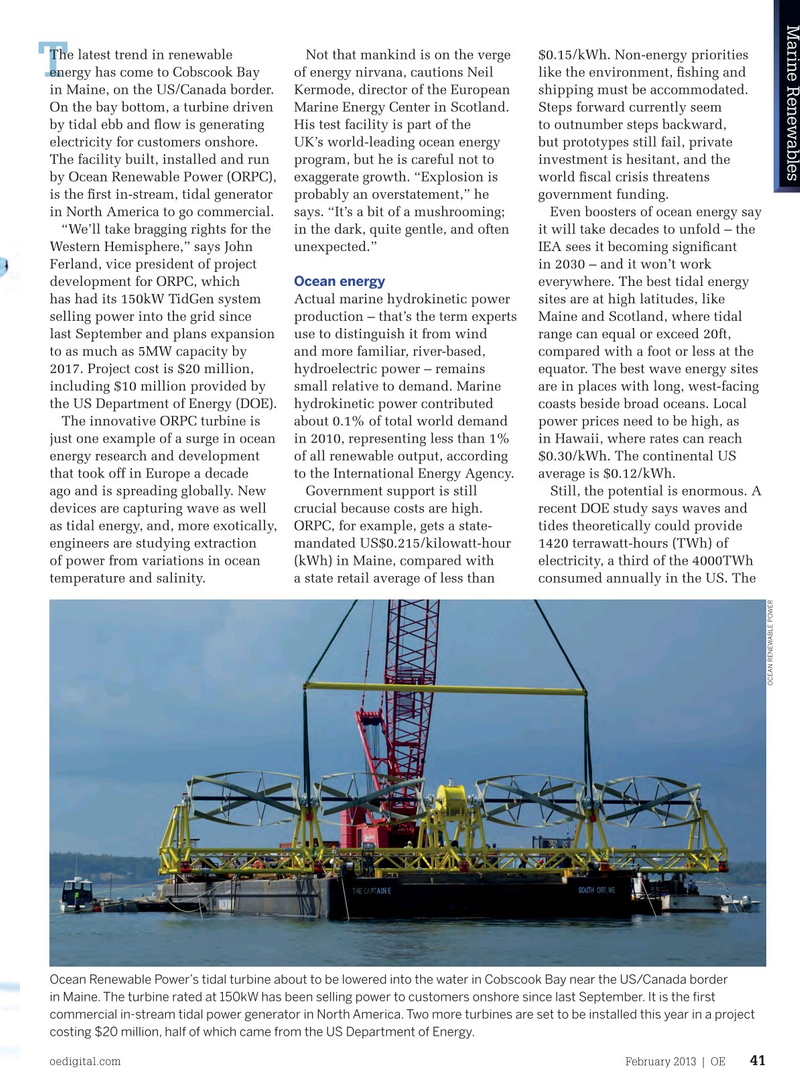
Page 39: of Offshore Engineer Magazine (Feb/Mar 2013)
Read this page in Pdf, Flash or Html5 edition of Feb/Mar 2013 Offshore Engineer Magazine
Marine Renewables
The latest trend in renewable Not that mankind is on the verge $0.15/kWh. Non-energy priorities energy has come to Cobscook Bay of energy nirvana, cautions Neil like the environment, ? shing and
T in Maine, on the US/Canada border. Kermode, director of the European shipping must be accommodated.
On the bay bottom, a turbine driven Marine Energy Center in Scotland. Steps forward currently seem by tidal ebb and ? ow is generating His test facility is part of the to outnumber steps backward, electricity for customers onshore. UK’s world-leading ocean energy but prototypes still fail, private
The facility built, installed and run program, but he is careful not to investment is hesitant, and the by Ocean Renewable Power (ORPC), exaggerate growth. “Explosion is world ? scal crisis threatens is the ? rst in-stream, tidal generator probably an overstatement,” he government funding.
in North America to go commercial. says. “It’s a bit of a mushrooming; Even boosters of ocean energy say “We’ll take bragging rights for the in the dark, quite gentle, and often it will take decades to unfold – the
Western Hemisphere,” says John unexpected.” IEA sees it becoming signi? cant
Ferland, vice president of project in 2030 – and it won’t work development for ORPC, which Ocean energy everywhere. The best tidal energy has had its 150kW TidGen system Actual marine hydrokinetic power sites are at high latitudes, like selling power into the grid since production – that’s the term experts Maine and Scotland, where tidal last September and plans expansion use to distinguish it from wind range can equal or exceed 20ft, to as much as 5MW capacity by and more familiar, river-based, compared with a foot or less at the 2017. Project cost is $20 million, hydroelectric power – remains equator. The best wave energy sites including $10 million provided by small relative to demand. Marine are in places with long, west-facing the US Department of Energy (DOE). hydrokinetic power contributed coasts beside broad oceans. Local The innovative ORPC turbine is about 0.1% of total world demand power prices need to be high, as just one example of a surge in ocean in 2010, representing less than 1% in Hawaii, where rates can reach energy research and development of all renewable output, according $0.30/kWh. The continental US that took off in Europe a decade to the International Energy Agency. average is $0.12/kWh.
ago and is spreading globally. New Government support is still Still, the potential is enormous. A devices are capturing wave as well crucial because costs are high. recent DOE study says waves and as tidal energy, and, more exotically, ORPC, for example, gets a state- tides theoretically could provide engineers are studying extraction mandated US$0.215/kilowatt-hour 1420 terrawatt-hours (TWh) of of power from variations in ocean (kWh) in Maine, compared with electricity, a third of the 4000TWh temperature and salinity. a state retail average of less than consumed annually in the US. The
OCEANRENEWABLEPOWER
Ocean Renewable Power’s tidal turbine about to be lowered into the water in Cobscook Bay near the US/Canada border in Maine. The turbine rated at 150kW has been selling power to customers onshore since last September. It is the ? rst commercial in-stream tidal power generator in North America. Two more turbines are set to be installed this year in a project costing $20 million, half of which came from the US Department of Energy. oedigital.com February 2013 | OE 41 oe_renewables.indd 41 31/01/2013 10:44

 38
38

 40
40